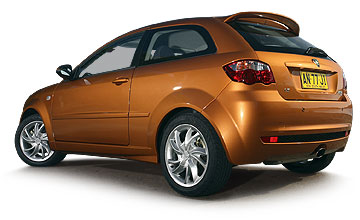BY BYRON MATHIOUDAKIS | 13th Feb 2007

And the only one you might consider was the visceral GTi, and that cost more than $25,000 and appealed to a very select, ‘boyracer’ demographic.
But it is fourth time lucky for the Malaysians, because the experience garnered from three previous attempts at an all-new car (2001 Waja, 2004 Gen2 and 2006 Savvy), combined with Lotus engineering know-how and a brand-new, state-of-the-art, Toyota-based manufacturing system, has given us the new Satria Neo.
Only the name is carried over, so this is no ex-Mitsubishi cast-off.
Satria Neo looks the part too, with interesting proportions for a coupe-like silhouette (featuring what might be the light-car segments’ fastest windscreen angle ever), as well as big wheelarches and some distinctive body detailing.
If you’re too young to remember Debbie Gibson’s Electric Youth, you’ll probably love it.
All right, so there’s more than a soupcon of Audi A3 styling in there, and Proton’s pencil pushers may have been inspired by previous Honda Civic hatchbacks, but the effect is sporty, youthful and undoubtedly attractive.
Inside, current Proton owners will not believe their senses, with a well- presented dashboard that Ford Fiesta drivers will find familiar, what with its rounded vent and door trim designs.
However it does work well, featuring a motorcycle-style gauge cluster, chunky little steering wheel, and cool D-shaped handbrake, while most of the controls – silly power window switches excepted – are where you might expect them to be.
Access to the fairly tight back seat is reasonable from the passenger side, thanks to a somewhat fiddly seat-slide mechanism, but there is not one on the driver’s side, and that is infuriating.
More seriously, the driver’s seat is set too high, even for average-sized adults, despite the inclusion of a clumsy cushion-tilt knob. The glovebox is small, the cupholders are more like thimble holders and, on two (pre-production) GX test cars, the driver’s seat material stretched and looked saggy, like an old taxi. It’s a good thing Proton offers a three-year/unlimited kilometre warranty then.
Overall, though the Satria Neo’s interior is up to scratch.
It is also a prelude for what’s in store for keen drivers, because Proton has certainly done well to utilise Lotus’s dynamics expertise.
Take the steering – it feels lively and informative in your hands, connecting you to the front wheels better than any sub-$20K baby car this side of a Fiesta.
The Satria Neo corners with confidence and poise, rides over all types of road irregularities with ease and has the body control to help keep it all together, along with a hard-working set of (four-wheel) disc brakes.
In some scenarios, where the roads snaked unevenly through tight curves, the Proton did reach the end of its bump stops, but then a quick check of the speedo revealed that the Neo was being driven with alarming brio, as if it were a seriously hot, hot-hatch in fact.
And that’s the thing about this little car... you forget it’s just a runabout because the dynamics do goad you on to drive it that little bit harder than you might expect.
The 1.6-litre engine is more lusty than refined, needing lots of revs before it delivers the sort of go the chassis demands.
To maintain momentum you have to keep the tachometer swinging past 4000rpm, rowing the car along using the beautifully weighted five-speed manual gearbox but there is sufficient torque up there for the Satria to be a surprisingly quick – if noisy – point-to-point device.
The four-speed automatic does an adequate job of keeping things moving, but you would then miss the manual’s delightful interaction.
Noise levels did vary, with some cars suffering from too much wind and engine roar, while others – like the manual GXR GoAuto drove for most of the time – impressing us with its relatively contained quietness.
The 15-inch tyres on the base GX transmit more noise and less grip than the GXR’s 16-inch Continental rubber, so saving up the extra $2000 for the latter might be worth it, especially considering how much better the new Satria looks for having alloy wheels and a nifty little roof spoiler.
From $18,990 driveaway, the Satria Neo seems expensive when compared to the more rounded Ford Fiesta LX or Suzuki Swift – the light-car class leaders that are closest in spirit to the Proton – but unlike the Ford, it does have ABS brakes as standard, along with rear parking radar, as well as sexier styling for many people.
The bottom line is, if you like the look and drive of it, we wouldn’t try to talk you out of buying a Satria Neo (but we would recommend that you haggle hard for a GXR).
We believe an involving, interesting car is always preferable to that of a dull, cynical one, and the personable Proton has what it takes to put a smile on your face.
So while little annoyances mean that the Satria Neo falls short of the best, you can certainly do a lot worse.
And we haven’t ever been able to say that about a Proton before.